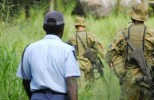Search
Using the filters to the left, click your selection, it will become bold and filter the results, click it again to remove that filter.
This reading list comprises notable works on littoral manoeuvre. It is by no means exhaustive, nor is it prescriptive. Reading lists are often a fraught endeavour: there are countless books, articles, reports, blogs, and podcasts concerned with any topic one might choose to study. As such, it is often better to present a selection of works with the caveat that what follows is a guideline on some of the most notable literature on the topic, in this case, ‘littoral manoeuvre’. The following works are all …
William Simonds , MA, is an Alumnus of the Department of Politics and International Relations, University of Reading, UK; and a serving member of the Canadian Army. … William Simonds …
Dr Ben Zweibelson is a retired US Army infantry officer with multiple combat tours to Iraq and Afghanistan. His latest book, ‘ Reconceptualizing War ’ is now available through Helion & Co. … Ben Zweibelson …
Australian Army Research Centre (AARC) The Australian Army Research Centre (AARC) was established in mid-2016 in accordance with the wishes of the then Chief of Army Lieutenant General Angus Campbell. It is the successor to the Land Warfare Studies Centre. It sits as a Directorate within the Army’s Future Land Warfare Branch in the Land Capability Division of Army Headquarters. Role The AARC conducts strategic studies, research and analysis, fosters debate and advocates the value of the joint land force …

Army MakerSpace About MakerSpace Makerspace is an Army initiative providing a place for learning-by-making and education in innovative approaches, creative thinking, and agile methodologies. All Army personnel are invited to join their local community of makers to gain a professional toolbox of problem-solving techniques to tackle Army’s current and emerging challenges. Makerspace is part of The Robotic and Autonomous Systems Implementation & Coordination Office (RICO) within Future Land Warfare Branch …

Titles to Note Listed below is a selection from the review copies that have arrived at the Australian Army Journal . Reviews for many of these books can be found online using the search function and filtering for the Journal Article Content Type, and Book Review Publication Type. Alternately you can browse through the range of online Australian Army Journal editions. Honor and Fidelity: The 65th Infantry in Korea , 1950-1953, Gilberto N Villahermosa Brent, Scribe Publications, ISBN 9780160833243, 329 pp. …
Listed below is a selection from the review copies that have arrived at the Australian Army Journal . Reviews for many of these books can be found online using the search function and filtering for the Journal Article Content Type, and Book Review Publication Type. Alternately you can browse through the range of online Australian Army Journal editions. North Korea on the Brink, Glyn Ford with Soyoung Kwon, Pluto Press, ISBN 9780745325989, 249 pp. (Distributed in Australia by Palgrave Macmillan) Reporting …
Listed below is a selection from the review copies that have arrived at the Australian Army Journal. Reviews for many of these books can be found online using the search function and filtering for the Journal Article Content Type, and Book Review Publication Type. Alternately you can browse through the range of online Australian Army Journal editions. • North Korea on the Brink , Glyn Ford with Soyoung Kwon, Pluto Press, ISBN 9780745325989, 249 pp. (Distributed in Australia by Palgrave Macmillan) • …
Listed below is a selection from the review copies that have arrived at the Australian Army Journal . Reviews for many of these books can be found online using the search function and filtering for the Journal Article Content Type, and Book Review Publication Type. Alternately you can browse through the range of online Australian Army Journal editions. Military Ethics , C A J Coady and Igor Primoratz, Ashgate Publishing, ISBN 9780754624875, 546 pp. More than an Ally? Contemporary Australia–US Relations , …
Collective contributions to future land power As we argued in an earlier post , if recent operations such as Anode, Sovereign Borders and the response to MH17 are any indication, Army and the Australian Federal Police (AFP) are likely to provide important collective contributions to land power into the future. While government policy may be pursued through the formation of joint agency headquarters with a continuance of relatively uninterrupted activities along existing departmental lines (e.g. …


